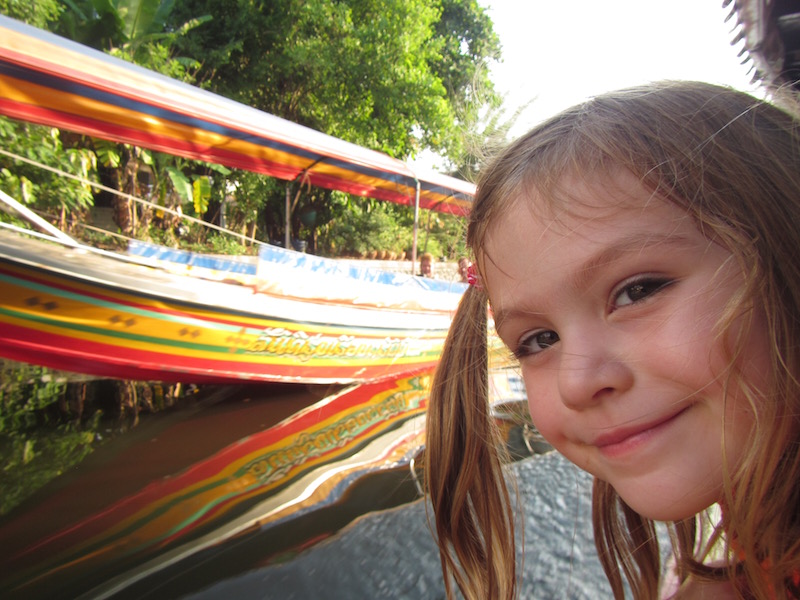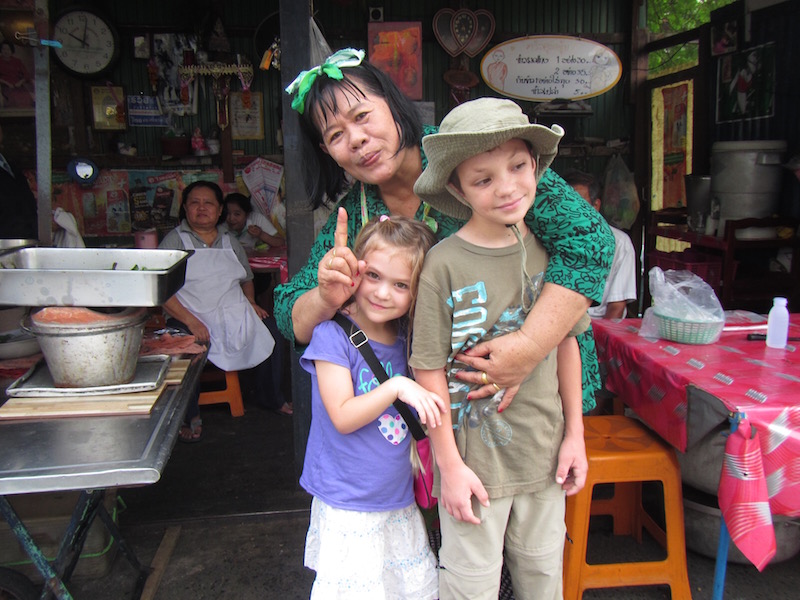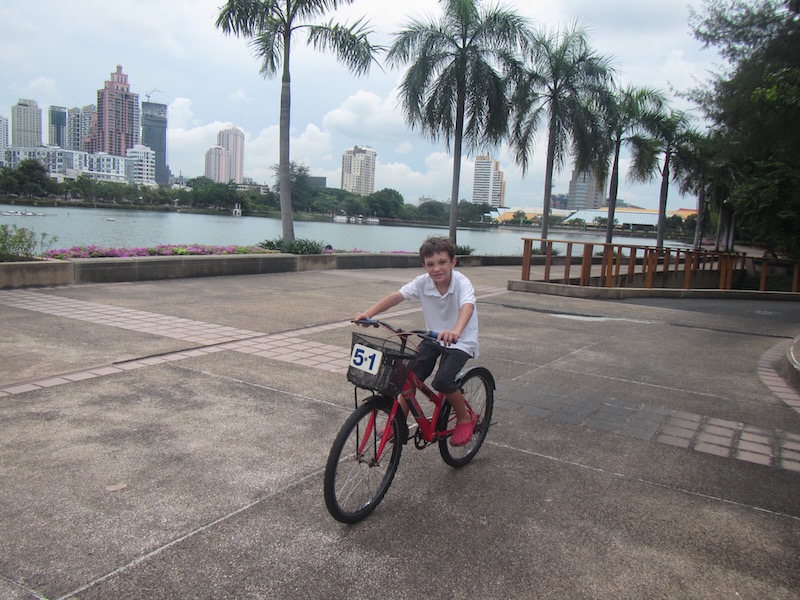 When Pierre and I announced we were traveling the world with our two young children for a couple of years, and that we planned to spend a good chunk of that time in Southeast Asia, some family and friends worried for us. Southeast Asia, after all, is not America, or Europe, for that matter.
When Pierre and I announced we were traveling the world with our two young children for a couple of years, and that we planned to spend a good chunk of that time in Southeast Asia, some family and friends worried for us. Southeast Asia, after all, is not America, or Europe, for that matter.
My mother worried that one of our planes might crash, or our kids might get kidnapped. Others wanted to know: What if your children get separated from you? Or lost? What if they get seriously sick? Or injured? Or bitten by a cobra, or a rabid dog? What if the ferry boat you’re on goes down? Or something happens to you and your husband?
For the record, a few of these ugly fears have flashed through my mind as well, but I don’t let them stay there. It helps to know the truth. Statistically speaking, for example, the chance of dying in a plane crash is one in 11 million. The chance of a kidnapping in the U.S. is one in 126,000. And given the recent terrorist attacks in Paris, I’ll also add that the chance of dying from terrorism is one in 20 million.
Some of these worries are natural, though, and can intensify when traveling to a foreign country, where the language, customs, laws, infrastructure, and so much more is so different than our own.

Most boil down to fear of the unknown, and current media coverage doesn’t help. While traveling, I’ve spoken to a number of intelligent people who fear a visit to the U.S. Why? Because they are genuinely afraid they might die in a shooting. It’s true that many U.S. cities have violent gun crimes that are worse than in countries we plan to visit.
There is a remedy for these types of fears: get to know the unknown! Learn about the place you plan to visit, the truth about your fears (by putting them in perspective), and know what to do in case something really does go wrong.
Keeping kids safe while traveling requires preparation and a lot of common sense. I find it also doesn’t hurt to remind myself that there are kids thriving in the countries we plan to visit. Here are some of the steps we take while traveling to help keep our kids healthy and safe, from the big to the mundane.
#1 Check the Safety and Security of Your Target Country
Before visiting a country, I always check the U.S. State Department’s Safety and Security page to see if anything stands out. Is there massive political unrest because it’s an election year? Well, we’ll visit another year. Are there almost daily, ongoing terrorist bombings or kidnappings? We’ll just have to cross that region off the list.
It’s important to know, though, that no place, even home, is perfectly safe. I temper my judgement of the U.S. State Department’s assessment by also reading up on what other tourists, expats, or locals have to say.
The August, 2015 bombing in Bangkok, for example, didn’t stop us, or millions of other tourists and families, from visiting this beautiful, tourist-friendly country. However, based on the U.S. State Department’s recommendation, we certainly won’t be visiting the very south of Thailand, where they experience almost daily bombings.
#2 Vaccinate Your Kids
We vaccinate our kids (and us) against diseases for the countries we plan to visit. For this, check the CDC’s very comprehensive list of required vaccines and tips.
#3 Get World Travel Health Insurance!
You never know what might happen. It’s nice to know that if your child breaks his arm in Mongolia, as what happened to this traveling mother-son, he’ll be medevaced out to a major city. Our choice: World Nomads. They’ll also replace your lost GoPro.
#4 Take Measures to Not Lose Your Kids
This is probably everyone’s number one fear, including mine. When we travel, we have rules to minimize the chance our kids get lost, and we have a strategy in place in case, god forbid, they do. Preparation is key.
1) When we’re out and about, we assign one parent to one kid, so you have only that kid to think about. If you don’t have a one-to-one ratio of parents to kids, then do the next best thing, such as: you take Jane, I’ll take Kate and Tom.
2) If it’s busy, we hold our kids’ hands (sometimes, for dear life, as we pull them away from scooters driving haphazardly on sidewalks). For those under three, I pick them up and pop them into a carrier.
3) For our son, who is old enough, we attach contact information and instruct him on what to do with it. The information includes the address of where we’re staying in the local language, along with a map if needed, the hotel’s phone number, and/or our phone numbers. In Chiang Mai, when our son was seven, we had him carry such information along with enough money to catch a tuk-tuk back to the hotel if he got separated from us. Our son has an adventurous spirit, however, and loved waving down tuk-tuks and negotiating prices with drivers. It would work for him, but may not for your child, in which case see #4 below.
For the little ones, although they may carry your phone number, you will likely have to rely on strangers to help them make use of it. One parent writes his phone number on his child’s body with a sharpie. Good idea! And this same parent keeps a picture of his child on his phone to show others in case. Another good idea!
4) If lost, instruct your child to locate another mom with kids and show her the contact information. Otherwise, restaurant and shop owners can also work.
5) One traveling parent suggests making a meeting point with your child (if she/he is old enough), in case of separation. Good idea!

6) We also supply our kids with a whistle. They are instructed to use it if they are separated from us but still nearby, or if they are in an emergency situation. I recently asked my nine-year-old to wear the whistle at a Bangkok park in which I jogged in a loop in one direction, and he, separate from me, biked in the opposite direction. If he fell or had any problem, he was instructed to blow, and, theoretically, I would come running over.
Another traveling parent suggested a secret call to find each other in a crowd. Another good idea! Our son is also ready for his own phone, which he can use to call us if needed.
So far, our kids haven’t been lost, but it’s important to be prepared in case. Go over the rules with your kids, and then let it go and enjoy your travels!
#5 Know What to Do In Case Something Happens to You
We have not done this yet, but need to. Ensure your children know who to call or where to go in case something happens to you, the parents. Have a phone number for them to call, or a local person to contact, in case, say, both parents get seriously sick at once.
We have also designated a friend at “home” as our “watcher.” We inform her of our itinerary every time we move and have supplied her with our will as well as other contact information in the very unlikely event something ugly or unfortunate happens to us.
#6 Know the Nearest Hospital and Emergency Medical Number
Get the address and phone number of the nearest hospital wherever you will be staying. If needed, have the address available on a map on your smartphone (with a local SIM card), or in the local language, for a taxi driver. Find out if the country has a medical emergency phone number (just as the U.S. has 911) and keep it handy.
#7 Carry Medical Supplies, Especially Mosquito Repellent
We always take with us a first aid kit, as well as strong mosquito repellant when visiting a tropical country where mosquitoes are known to carry dengue fever or malaria. (Note: Anti-malaria drugs are available but come with their own issues. We opt for prevention with insect repellent.)
#8 Know and Follow Local Customs and Laws
Learn about local customs and laws and respect them. Cars may stop for you at a zebra crossing at home, for example, but not so in Thailand or India (or Italy, for that matter).
#9 Take Measures to Avoid Travel Tummy
To help prevent travel-related diarrhea in certain destinations, I have our kids (and us) take probiotics for a week before we leave and for up to three weeks after we arrive. We also take other precautions, depending on the destination: We don’t drink the tap water. I have our kids brush their teeth with bottled water as an extra precaution. No drinks with ice unless we are certain the place purifies water for ice. No fresh cut fruit unless we know it has been washed in clean, pure water, or our tummies have adapted.
#10 Watch How You Enter and Exit Vehicles
This is just common sense, but worth a mention. When entering or exiting taxis, trains, and other vehicles, be sure that one of the parents (not a child) is the last out of the vehicle. Same with getting into a vehicle, but in reverse: make sure one parent goes in first. With two parents, one goes first, and one goes last.
#11 Bonus Tip: Don’t Take Unnecessary Risks. Make Smart Choices.
This too is just common sense: Make smart, informed choices, based on your risk tolerance, but with kids in mind. Pierre and I alone might hike 10 miles through a dense jungle to reach an isolated village, but would we put the risk of running into cobras, among other threats, on our kids? No way! Not to mention that our kids can’t (or won’t) hike 10 miles anyway.
This is a personal choice, but we also bring life vests for younger kids when we travel to ocean/beach destinations. Yes, they are bulky and add to our very limited luggage quota, but they can be useful too. Around deep water, the rules change if the kids have their life vests on. They enjoy more freedom, while we enjoy less worry. Also, for situations such as crossing the ocean from Kho Tao to Nang Yuan Island in a long-tail boat in borderline stormy weather (as we did), I feel better if the ones who can’t swim have a flotation device on. Even on sea-crossing ferries with plenty of life vests, they don’t usually carry many children’s life vests. But then, when catching the often packed orange boat in Bangkok, for example, it’s impractical to bring along life vests. That’s when you remind yourself that the chances of dying from a boat sink are miniscule.
Some general safety tips for traveling with kids can be found here. And safety tips from other nomadic families include this and this. Be safe, and enjoy your travels!
This blog post is copyrighted (c) 2015 by Cindy Bailey and is an original publication of www.mylittlevagabonds.com. Please join us on Twitter and Facebook. Happy travels!
so precious tips :o) thank you very much